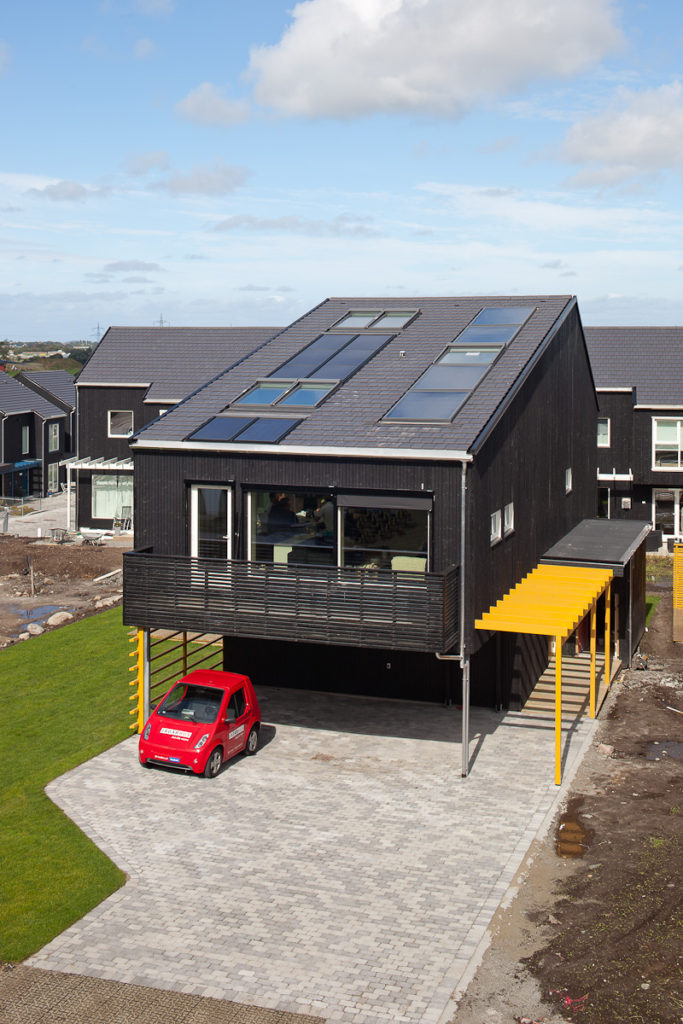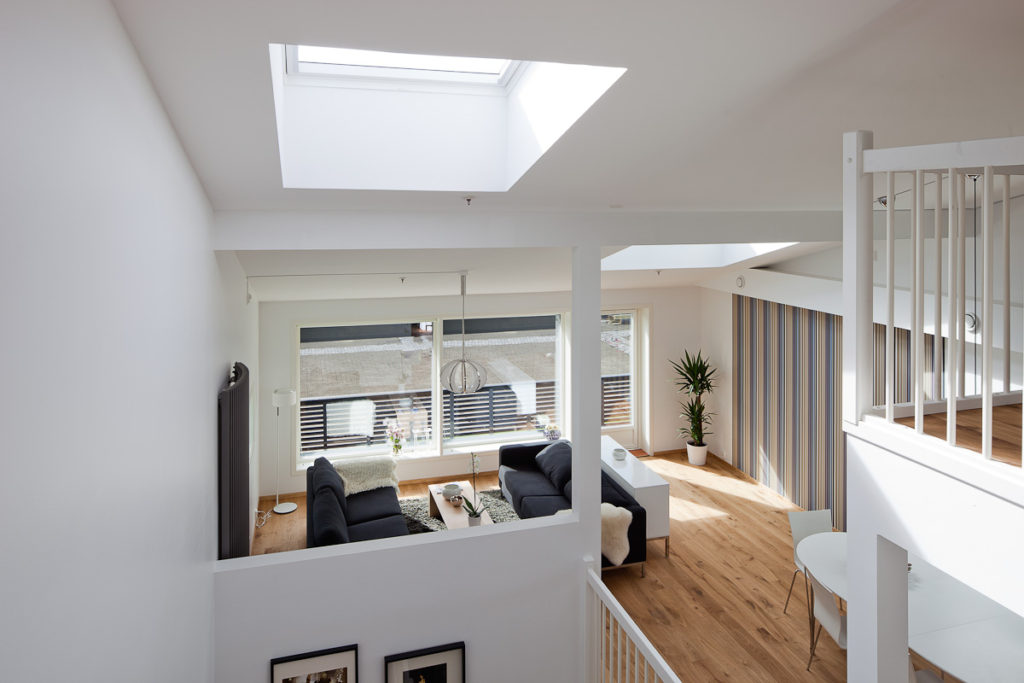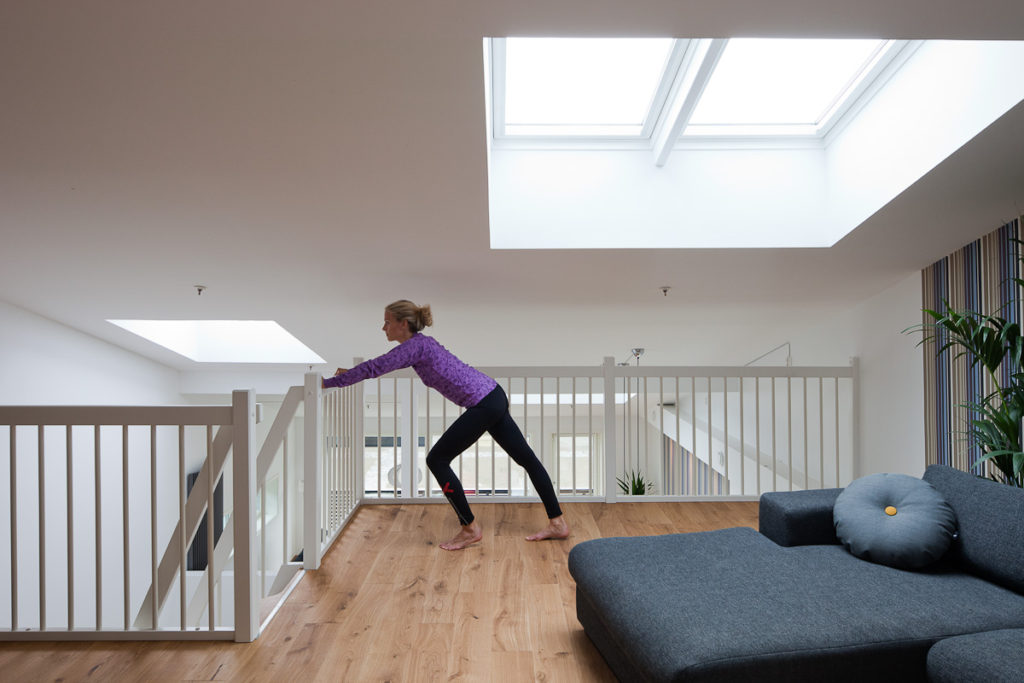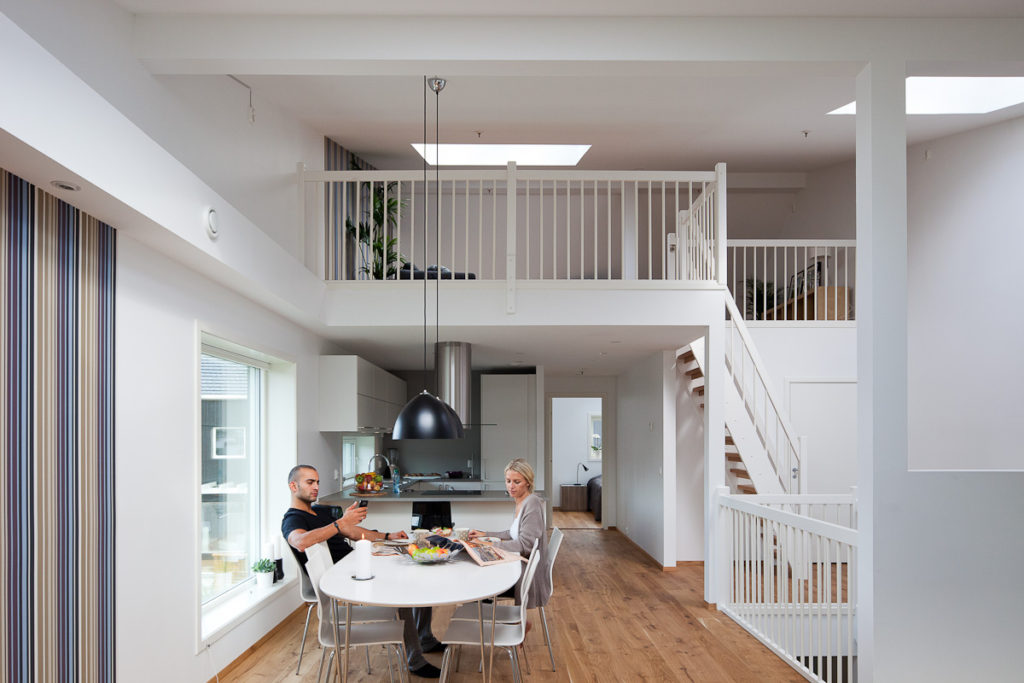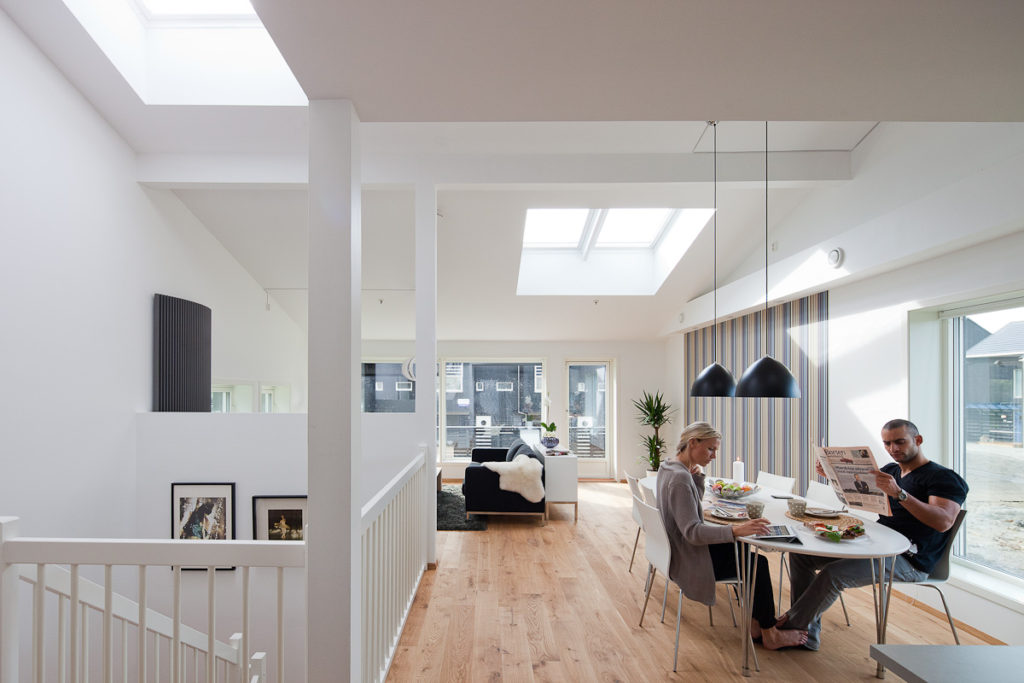Isobo Aktiv – A House for the Future
Energy rating A (A++). The building is based on passive measures such as extra insulation, extra tight building envelope and good windows.
Apart from the passive measures, solar collectors, solar cells, heat pump air-liquid, balanced ventilating system with heat recovery of the countercurrent unit type (with an efficiency of minimum 90%) connected to ground collector (ground heat) have been installed.
Area: Floor space 178 m2 (BRA)
Energy consumption: Calculated energy need for the building 7919 kWh, specifically delivered energy 44,4 kWh/m2. Solar collector unit and heat pump (air-liquid) cover 95% of space heating and 90% of hot water requirement for the buildings yearly energy requirement. The house has 8 solar cell panels yielding 1230 kWh per year. The house has a ground collector (ground heat) as well; when used for intake air to the ventilating plant it improves the efficiency of the recovery unit.
7 steps of ISOBO Aktiv
Solar collector
Hot water and space heating
The house has 4 solar collectors with an absorber area of about 8 m2. Calculated to cover 50% of the required hot waster consumption. Calculated to provide 10% of the required heating by radiators and under-floor heating in the bathroom.
Heat pump
Hot water and space heating
Calculated to cover 40% of the required hot water consumption. Calculated to provide 85% of the required heating by radiators and under-floor heating in the bathroom. Air-to-water heat pump. Uses outdoor air to heat utility water and water for radiators/under-floor heating.
Ground collector
Preheated or precooled air
A ground heat collector with a piping system which is placed under the house. It is connected to the ventilating unit to increase efficiency and ensure a more even temperature in the house. On cold days the intake air to the ventilating unit is preheated so that it will require less energy to heat the air sent into the house. On hot days the intake air of the ventilating unit is cooled so the air sent into the house has a lower temperature than normal.
Balanced ventilation
Fresh air and minimal heat loss
A most efficient ventilating unit is used; the efficiency has been calculated to more than 90%.
Hot water unit
Preheated water from solar collectors and heat pump
The hot water unit is storing the heat produced by the solar collectors and the heat pump and has a tank for hot utility water and one for the building’s heating system. Active control of the hot water unit ensures that energy by the most environment-friendly source will be prioritized.
Intelligent windows and sunscreening
Light and ventilation create an optimal indoor climate
External sunscreening on selected windows with individual, active control. Active control system for opening and closing of selected windows for ventilation.
Solar cell panels
The house has 8 solar cell panels, system type Gevity™, integrated in the roof in specially constructed frames, which are ventilated to optimize the temperature and effect of the panels. Each solar cell panel has an effect of 160 wp; for all 8 panels the total is 1.28 kwp. The panels will produce approx. 1230 kWh per year, which is approx. 17% of the required electricity for light and appliances during the year. The surplus production is “sold” back to the energy supplier.
Energy:
All external construction units are better insulated than required by law (roof, external walls, beams towards the outside part of the first floor).
- Solid constructions do not require more maintenance than ordinary constructions (passive goal).
- The construction is more than seven times as tight as an ordinary TEK-10 construction (minimum requirement).
- Prevent air leakage though various parts of the construction.
- Prevent draft from the floor.
- Same temperature at the walls as in the middle of the room.
- Controlled air currents in the house. The construction is better insulated than required in an ordinary house. This corresponds to 30% higher U-value.
- Prevent thermal bridges at window areas. You can sit at the window without feeling cold. Roof windows let more light into the house and provide good ventilation.
- A roof window gives better and more pleasant light and saves energy by reducing the need for electric light.
- A roof window lets in twice as much light as a vertical window.
- Less energy is required for lighting in a passive house/low-energy house. Therefore, bulbs are used that require less current (e.g. LED lighting).
- Low-energy appliances/white goods are recommended with a good energy classification (A+ or A++).
- The property has a smarthouse technology system witch allows you to use a smart phone, to remote control for eksample light and heat as needed. To reduce the CO²-emission and improve the energy efficiency, the house must be considered as a whole, not just as the sum of its components. Energy efficiency is an integrated part of planning the house and available natural resources such as sun and air are used to their maximum.
Windows e.g. must be considered sources of energy. They must be placed strategically correct to contribute with heating and natural ventilation. A flexible building will prevent super heating and glare when the sun is high in the sky. Consequently, VELUX roof windows are equipped with electrically controlled awning blinds – either managed by the users of by the fully automatic steering system io-homecontrol ®.
VELUX solar collectors are integrated in the ISOBO Aktiv house roof to the south and provide hot water (+space heating). VELUX solar collectors can normally generate up to 70% of the energy required for production of hot water.
As much daylight and as good ventilation as possible are the preconditions for the optimal indoor comfort and the minimal energy consumption required in the future.
In a world facing increasing health problems (partly due to an increased number of allergic cases) the indoor climate is an important issue when designing buildings.
Several studies show that daylight has a positive effect on health, productivity, children’s learning ability, and wellbeing in general. In the same way, fresh air through natural ventilation will be decisive for the creation of a healthy indoor climate and reduction of the consequences of toxic emissions from e.g. electronical equipment and chemicals in the building – something that will reduce the risk of developing allergies.
Automatic control of natural ventilation and indoor temperature in an ISOBO Aktiv house is based on a fully automatic steering system of the io-home-control® type. This system is controlling all the strategically placed VELUX roof windows and sunscreening.
The active VELUX climate control provides climate control in a house with a quite new dimensions by opening and closing windows and sunscreening systems automatically according to changes of sunlight and temperature.
All things considered, the electrical VELUX products provide new solutions for better comfort at home, energy savings, safety and indoor climate control.
Integration
All io-homecontrol® components in the house speak the same language. The same remote control will manage everything – opening, closing, airing, turning heat on or off, etc. You can do what you want in your home even when you are away.
Immediate feedback
All user commands are controlled and confirmed by a sound signal or a visual signal. You can check the status on the house or a component in the house (open/closed, on/off) at any time.
Simple and reasonable
It is not necessary to install a central control panel or extra cables; all you need is electricity for the components. All the io-homecontrol® components are simple to install without extra cost.
The practical remote control makes is simple to maintain a comfortable indoor climate. VELUX automation for the home, based on io homecontrol ®, gives you light and fresh air by pushing a button.
Sandved Vest is a development area started up in spring 2008 and finished in the summer 2011. It has been divided into 3 phases and consists of 12 houses, 18 linked houses, 36 terrace houses and 16 apartments. Twelve Jadarhus Isobo low-energy houses have also been built (based on Husbanken’s criteria from 2004). These are 3 houses and 9 linked houses.
One of the purposes of these ISOBO Aktiv houses is to test different technical solutions in one single building. Another purpose is to look at which measures must be taken to get the best possible, optimal indoor climate, especially, with a view to avoiding super heating. Combined roof and vertical windows are used to help ventilating the house, but by choosing active ventilation of the house, you will need more roof windows than normally.
The house will be constructed as a timber house with traditional rafter construction. By using our usual construction partners, all construction units will be delivered as precut, industrially produced by Optimera. This means that all construction parts will be delivered dry to the building site ready for assembly. The house will be sold on the condition that it should be accessible for 2 years for logging of the users’ experience and monitoring of the performance.
Normally you will not get a full house at your disposition for ”research”. We want to use this unique opportunity to test as many as possible technical solutions to find out which gains and challenges they present. During the building period and the two years where the house is used as test house, we hope to get information and results, which will tell us what we should go for in our district. We are aware that this house has a lot of technical solutions demanding more than usual from the ordinary user, but this is also something we want to get some experience with. To get space for the different technical solutions we will use the room under the stairs as technical control room and we will among other things lower the floor to get more volume. In addition to this the garden shed will be somewhat enlarged to provide room for the ventilating plant and the ground collector. Consequently, the shed will be insulated and get a drain to get rid of possible condensation from the ventilating unit (countercurrent exchanger).
Torer Berg, SINTEF senior researcher, is not in doubt; Norwegians are much too spoiled with low energy prices. He is expecting considerable price increases in the coming years, mainly because the politicians want to make us conscious of saving energy. − Compared to the rest of Europe, we have low energy prices. But we cannot continue this way. It is, therefore, important that the building industry is offering energy solutions such as Jadarhus is doing with ISOBO Aktiv, the senior researcher says. ISOBO Aktiv has better insulated walls, floor and roof as well as an air tight construction and windows with less heat loss. But won’t such houses be too tight?
− The answer is balanced ventilation. We must be able to control what comes in and what leaves the house and the ventilating unit must utilize the heat of the air. Many think that we shall soon be building low-energy houses that generate their own heating so that we will not need any heating source. Low-energy houses will use ground heating and heat from the electronics in the house, Berg answers.
− ISOBO Aktiv is one of the most sensible house purchases that you can make. This investment will pay back already the first year in form of low energy costs. Furthermore, the future sales price will be much higher, Berg says. The senior researcher has worked together with Jadarhus for a long time and finds that the company has the right focus.
− Jadarhus has for many years been far ahead when it comes to energy savings in the building trade. Jadarhus is e.g. always one step ahead of legislation within this area. This was the case both in 2003 and when the new rules were passed in 2009. It shows that they are taking energy saving seriously, the SINTEF researcher says


